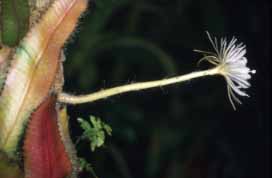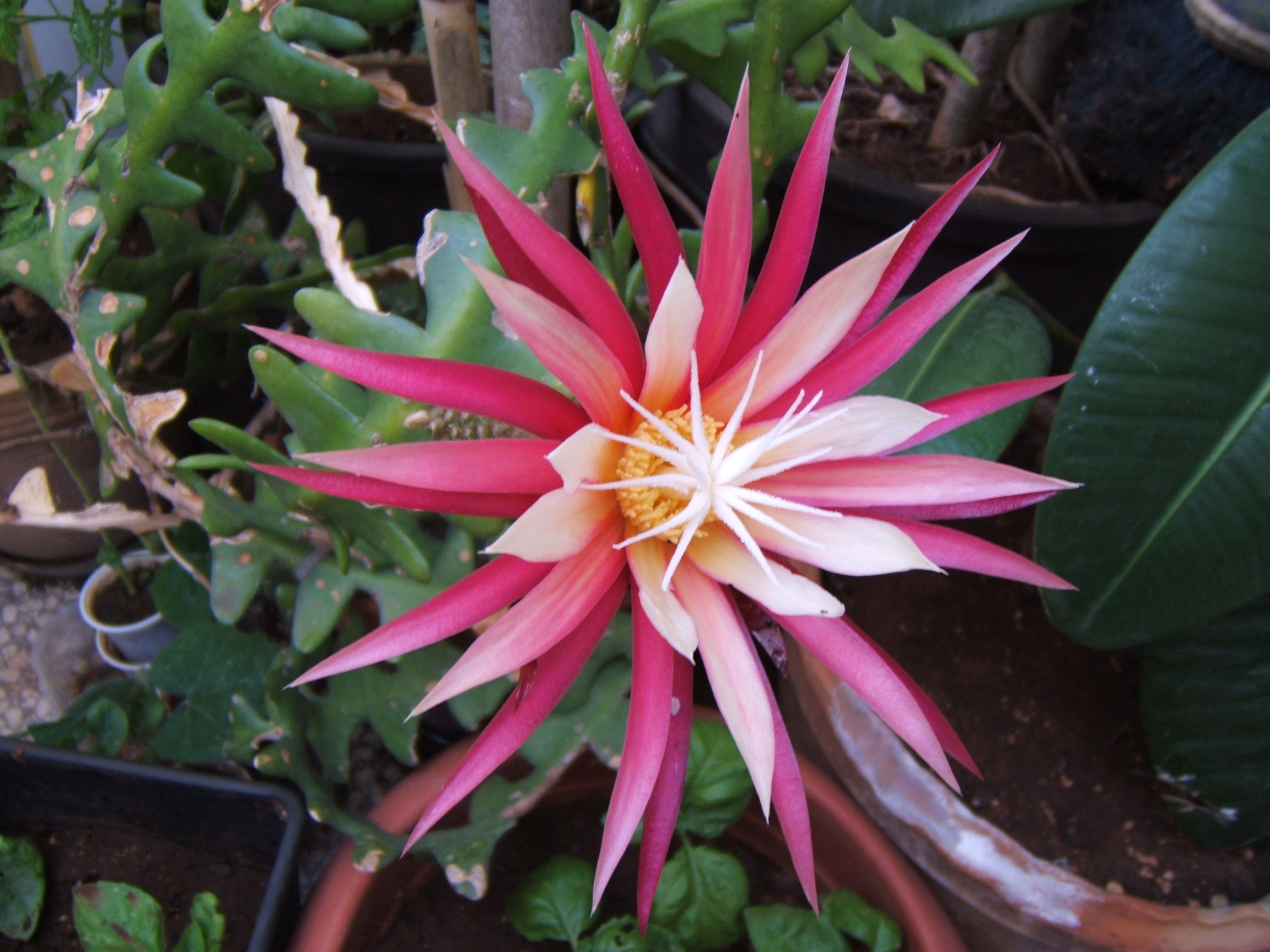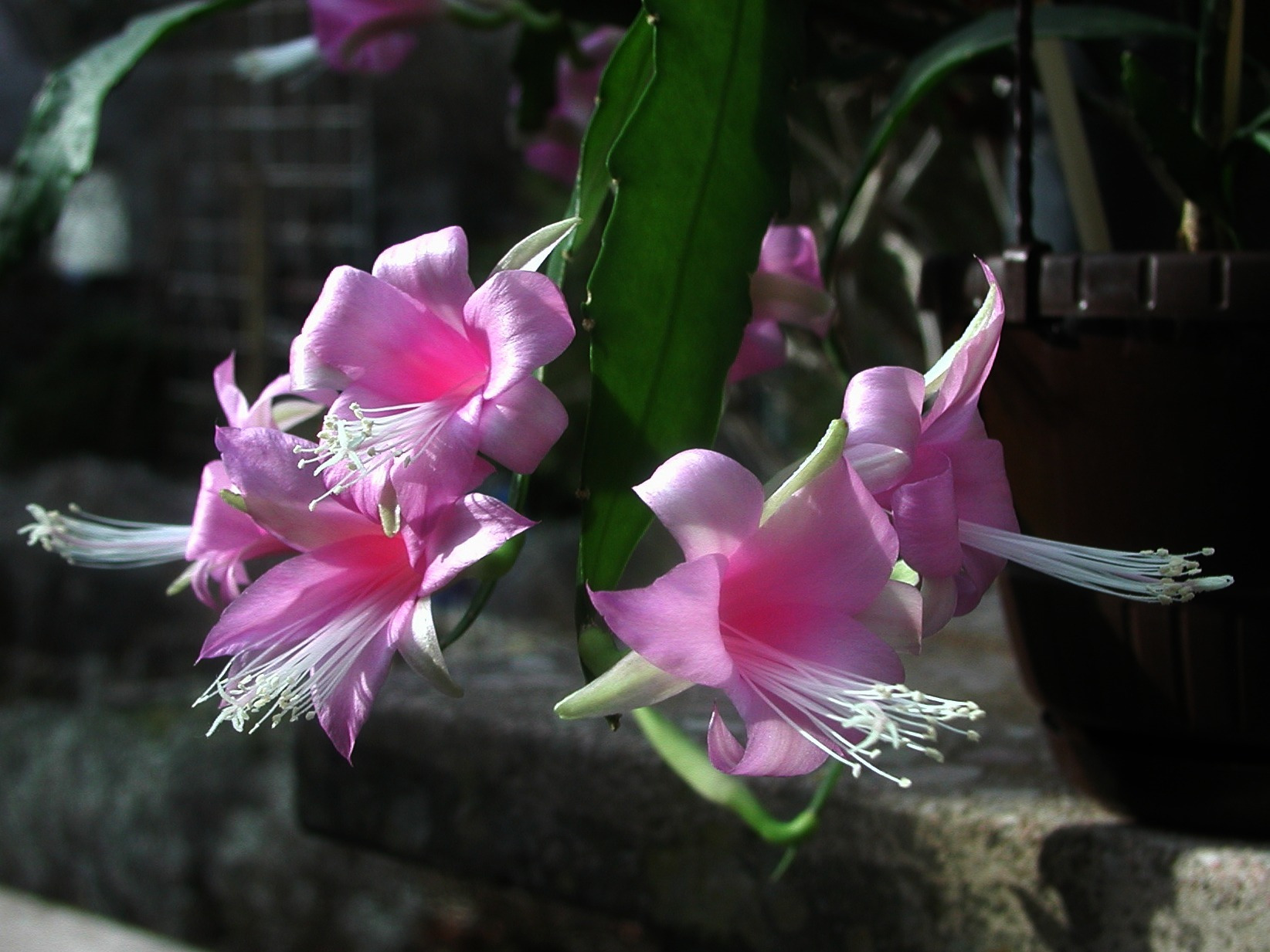|
Hylocereeae
The Hylocereeae are a tribe of cacti. Most are found in the tropical forests of Central and northern South America, and are climbers or epiphytes, unlike most cacti. The tribe includes between six and eight genera in different circumscriptions. The plants known as "epiphyllum hybrids" or "epiphyllums", widely grown for their flowers, are hybrids of species within this tribe, particularly ''Disocactus'', ''Pseudorhipsalis'' and ''Selenicereus'', less often ''Epiphyllum'', in spite of the common name. Description The members of the tribe are very variable in their morphology, especially when the terrestrial ''Acanthocereus'' is included. Many species form aerial roots. The hylocereoid clade (''Selenicereus'', ''Weberocereus'' and probably ''Aporocactus'') are mostly climbing or epiphytic, and have spiny ribbed stems. The phyllocactoid clade (''Epiphyllum'', ''Disocactus'', ''Kimnachia'' and ''Pseudorhipsalis'') are mainly epiphytic, and have spineless flattened leaf-like stems. F ... [...More Info...] [...Related Items...] OR: [Wikipedia] [Google] [Baidu] |
Epiphyllum Hybrid
Epiphyllum hybrids, epiphyllums, epicacti, or just epis, also known as orchid cacti, which are widely grown for their flowers, are artificial hybrids of species within the group of cacti placed in the tribe Hylocereeae. In spite of the common name, epiphyllum hybrids mainly involve ''Disocactus'' species instead of ''Epiphyllum'' species, though ''Selenicereus grandiflorus'' and some unconfirmed ''Epiphyllum'' species were reportedly used for hybridization. Other sources include '' Pseudorhipsalis'' in the parentage of the group., p. 286 Nothospecies Named nothospecies include: * ''Disocactus'' × ''amaranthinus'' (Regel) M.H.J.van der Meer: ''D. crenatus'' × ''D. phyllanthoides'' * ''Disocactus'' × ''charltonii'' (Mast.) M.H.J.van der Meer: ''D. crenatus'' × ''D. speciosus'' * ''Disocactus'' × ''coopermannii'' (Worsley) M.H.J.van der Meer: ''D. crenatus'' × ''D. phyllanthoides × D. speciosus'' * ''Disocactus'' × ''jenkinsonii'' (McIntosh) M.H.J.van der Meer (syn. ... [...More Info...] [...Related Items...] OR: [Wikipedia] [Google] [Baidu] |
Strophocactus Wittii
''Strophocactus wittii'', synonym ''Selenicereus wittii'', known as the Amazon moonflower, is a species of plant in the genus '' Strophocactus'' in the cactus family (Cactaceae), and is one of several species commonly called "moonflowers". It was first described in 1900 and is one of three species of cactus found in the central Amazon basin. It grows epiphytically on the trunks of trees in seasonally flooded forests of the Amazon basin, which is regularly flooded for a few weeks each year. During this time, the seeds spread through the water, which is unique within the cactus family. Description Vegetative characteristics ''Strophocactus wittii'' grows as an epiphyte, creeping and climbing up trees. The richly branched, leaf-like, flattened stems are phylloclades, and are pressed close to the tree trunks of their carriers and form aerial roots along their midrib. When exposed to direct sunlight, the elliptical to lanceolate, dark green shoots turn dull red due to strong b ... [...More Info...] [...Related Items...] OR: [Wikipedia] [Google] [Baidu] |
Selenicereus
''Selenicereus'', sometimes known as moonlight cactus, is a genus of epiphytic, lithophytic, and terrestrial cacti, found in Mexico, Central America, the Caribbean and northern South America. The term night-blooming cereus is also sometimes used, but this is also used for many night-blooming cacti, including ''Epiphyllum'' and ''Peniocereus''. In 2017, the genus ''Hylocereus'' was brought into synonymy with ''Selenicereus''. A number of species of ''Selenicereus'' produce fruit that is eaten. The fruit, known as ''pitaya'' or ''pitahaya'' in Spanish or as dragon fruit, may be collected from the wild or the plants may be cultivated. Description Clambering plants with flat to angled stems, producing aerial roots. Areoles may be with or without spines. Flowers are large and nocturnal, pollinated by moths or rarely bats. The receptacle bears small bracts, hairs and usually spines. Fruits bear numerous spines. Flowers are generally produced in abundance with mature plants and are t ... [...More Info...] [...Related Items...] OR: [Wikipedia] [Google] [Baidu] |
Acanthocereus
''Acanthocereus'' is a genus of cactus, cacti. Its species take the form of shrubs with arching or climbing stems up to several meters in height. The generic name is derived from the Greek language, Greek word ''άκανθα'' (''acantha''), meaning spine, and the Latin word ''cereus'', meaning candle. The genus is native to the mostly Tropics, tropical Americas from Texas and the southern tip of Florida to the northern part of South America (Colombia and Venezuela), including islands of the Caribbean. Description The plants form bushes which later usually overhanging or spreading and are rarely tree-shaped. Stems have 3 to 5 ribs, typically thin, with stout spines. The large, white, funnel-shaped flowers are night-opening, long and in diameter and open at night. The little scaly pericarpel and the long, stiff, upright flower tube are covered with a few thorns that soon decay and little wool. The fruits are spherical to ovoid or pear-shaped red or green, bare or thorny, tear ... [...More Info...] [...Related Items...] OR: [Wikipedia] [Google] [Baidu] |
Disocactus Biformis
''Disocactus'' is a genus of epiphytic cacti in the tribe Hylocereeae found in Central America, the Caribbean and northern South America. It should not be confused with '' Discocactus'', which is a different genus. Species of ''Disocactus'' grow in tropical regions either on trees as epiphytes or on rocks as lithophytes. They have two distinct growth habits. Species such as '' D. phyllanthoides'' have stems which are round at the base but then become flattened and leaflike. Many of the cultivated plants known as epiphyllum hybrids or just epiphyllums are derived from crosses between species of ''Disocactus'' (rather than ''Epiphyllum'') and other genera in the Hylocereeae., p. 286 Description The species of the genus ''Disocactus'' grow as epiphytes or lithophytes and are shrubby, profusely branched, hanging, up to 3 m long. The shoots are ribbed or flattened, 3-angled or flattened, ribbon-like, 3–10 mm wide, remotely crenate and leaf-like. The main shoot, which ... [...More Info...] [...Related Items...] OR: [Wikipedia] [Google] [Baidu] |
Disocactus
''Disocactus'' is a genus of epiphytic cacti in the tribe Hylocereeae found in Central America, the Caribbean and northern South America. It should not be confused with ''Discocactus'', which is a different genus. Species of ''Disocactus'' grow in tropical regions either on trees as epiphytes or on rocks as lithophytes. They have two distinct growth habits. Species such as '' D. phyllanthoides'' have stems which are round at the base but then become flattened and leaflike. Many of the cultivated plants known as epiphyllum hybrids or just epiphyllums are derived from crosses between species of ''Disocactus'' (rather than ''Epiphyllum'') and other genera in the Hylocereeae., p. 286 Description The species of the genus ''Disocactus'' grow as epiphytes or lithophytes and are shrubby, profusely branched, hanging, up to 3 m long. The shoots are ribbed or flattened, 3-angled or flattened, ribbon-like, 3–10 mm wide, remotely crenate and leaf-like. The main shoot, which rot ... [...More Info...] [...Related Items...] OR: [Wikipedia] [Google] [Baidu] |
Acanthocereus Subinermis
''Acanthocereus'' is a genus of cacti. Its species take the form of shrubs with arching or climbing stems up to several meters in height. The generic name is derived from the Greek word ''άκανθα'' (''acantha''), meaning spine, and the Latin word ''cereus'', meaning candle. The genus is native to the mostly tropical Americas from Texas and the southern tip of Florida to the northern part of South America (Colombia and Venezuela), including islands of the Caribbean. Description The plants form bushes which later usually overhanging or spreading and are rarely tree-shaped. Stems have 3 to 5 ribs, typically thin, with stout spines. The large, white, funnel-shaped flowers are night-opening, long and in diameter and open at night. The little scaly pericarpel and the long, stiff, upright flower tube are covered with a few thorns that soon decay and little wool. The fruits are spherical to ovoid or pear-shaped red or green, bare or thorny, tear-open or non-tear-open and contai ... [...More Info...] [...Related Items...] OR: [Wikipedia] [Google] [Baidu] |
Cactus
A cactus (, or less commonly, cactus) is a member of the plant family Cactaceae, a family comprising about 127 genera with some 1750 known species of the order Caryophyllales. The word ''cactus'' derives, through Latin, from the Ancient Greek word (''káktos''), a name originally used by Theophrastus for a spiny plant whose identity is now not certain. Cacti occur in a wide range of shapes and sizes. Although some species live in quite humid environments, most cacti live in habitats subject to at least some drought. Many live in extremely dry environments, even being found in the Atacama Desert, one of the driest places on Earth. Because of this, cacti show many adaptations to conserve water. For example, almost all cacti are succulents, meaning they have thickened, fleshy parts adapted to store water. Unlike many other succulents, the stem is the only part of most cacti where this vital process takes place. Most species of cacti have lost true leaves, retaining only spines, ... [...More Info...] [...Related Items...] OR: [Wikipedia] [Google] [Baidu] |
Kimnachia Ramulosa
''Kimnachia'' is a monotypic genus of cacti. Its only species is ''Kimnachia ramulosa'', synonym ''Pseudorhipsalis ramulosa'', which is native from southern Mexico to northern South America and also found in Jamaica. Description ''Kimnachia ramulosa'' is a shrubby plant, branching freely from the base. The stems are rounded basally, with branches that become flattened towards their tips. The branches are long and up to wide. They are reddish at first, later becoming green. The flowers are pinkish or greenish cream in colour, long and across. They are usually borne singly and hang downwards. The small whitish fruits are up to long. Taxonomy The species was first described by Joseph zu Salm-Reifferscheidt-Dyck in 1834, as ''Cereus ramulosus''. It was transferred to the genus '' Pseudorhipsalis'' in 1991. In 1993, Kimnach sank ''Pseudorhipsalis'' into ''Disocactus'' as section ''Pseudorhipsalis'', so ''Ps. ramulosa'' became ''Disocactus ramulosus''. A molecular phylog ... [...More Info...] [...Related Items...] OR: [Wikipedia] [Google] [Baidu] |
Aporocactus
''Aporocactus'' is a genus of cacti in the tribe Hylocereeae native to Mexico. It used to be classified as a subgenus in ''Disocactus'', but according to molecular evidence, it should be excluded from ''Disocactus'' and treated as a separate genus Genus ( plural genera ) is a taxonomic rank used in the biological classification of living and fossil organisms as well as viruses. In the hierarchy of biological classification, genus comes above species and below family. In binomial nom .... Description It is an epiphytic genus growing on the branches of trees, but without parasitizing them. Occurs as drooping or creeping stems up to 60 cm with 6 ribs covered with many small thorns. Extant Species There are two species in the genus ''Aporocactus'': References External Links * * {{Taxonbar, from=Q2858521 Hylocereeae Cactoideae genera ... [...More Info...] [...Related Items...] OR: [Wikipedia] [Google] [Baidu] |
Kimnachia
''Kimnachia'' is a monotypic genus of cacti. Its only species is ''Kimnachia ramulosa'', synonym ''Pseudorhipsalis ramulosa'', which is native from southern Mexico to northern South America and also found in Jamaica. Description ''Kimnachia ramulosa'' is a shrubby plant, branching freely from the base. The stems are rounded basally, with branches that become flattened towards their tips. The branches are long and up to wide. They are reddish at first, later becoming green. The flowers are pinkish or greenish cream in colour, long and across. They are usually borne singly and hang downwards. The small whitish fruits are up to long. Taxonomy The species was first described by Joseph zu Salm-Reifferscheidt-Dyck in 1834, as ''Cereus ramulosus''. It was transferred to the genus '' Pseudorhipsalis'' in 1991. In 1993, Kimnach sank ''Pseudorhipsalis'' into ''Disocactus'' as section ''Pseudorhipsalis'', so ''Ps. ramulosa'' became ''Disocactus ramulosus''. A molecular phylog ... [...More Info...] [...Related Items...] OR: [Wikipedia] [Google] [Baidu] |
Aporocactus Martianus
''Aporocactus martianus'' (syn. ''Disocactus martianus'') is a species of cactus found in Oaxaca, Mexico. Description ''Disocactus martianus'' grows creeping, occasionally forming lithophytic with aerial roots. It is a species of fleshy, cylindrical suspended or creeping cactus with stems up to 1.5 meters long and up to 2.5 centimeters thick, sometimes with aerial roots, with 8 to 10 slightly wart-shaped ribs; 3 or 4 central pale brown spines up to 12 mm long and 6 to 20 radial spines are light yellowish and only 5 to 7 millimeters long. The bright red flowers are diurnal and produced in summer, 10 to 12 centimeters in diameter and a length of 5 to 7 centimeters. The flowers stay open for a couple of days. They are followed by globose fruits of green color and 2 cm in diameter. It is viviparous. File:Discocactus martianus pm1.jpg, Flowers side File:Disocactus martianus 362203.jpg, Flowers Taxonomy & Systematics It was first described as ''Cereus martianus'' in 1837 by Ludwig ... [...More Info...] [...Related Items...] OR: [Wikipedia] [Google] [Baidu] |



_001.jpg)


